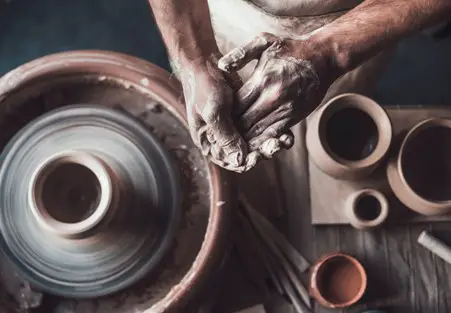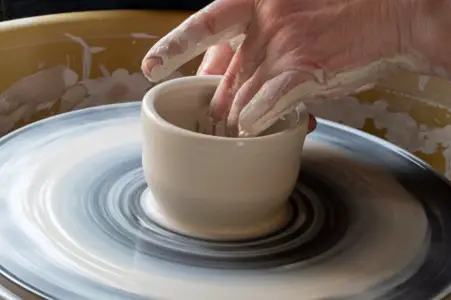Have you ever looked at a pottery wheel and wondered which direction it might turn? Pottery is an art that needs control, precision, and passion. There is a lot involved in pottery that combines as a unified whole to produce a beautiful pot. One such factor is the direction of the pottery wheel.
So, to answer the question of which way a pottery wheel turns, they turn clockwise and counter-clockwise depending on the desire of the potter. It also depends on the hand that the potter prefers to use. However, as the potter turns the wheel, one can learn both directions with patience and consistent practice.
Does the Dominant Hand Influence Wheel Direction?
It’s general information among many potters that right-handed people throw (that is, make pots out of clay) more efficiently when the wheel’s direction is anti-clockwise. Left-handed potters throw easily when the wheel is turning in a clockwise direction. There are two main explanations for how the dominant hand influences pottery.
-
Dominant Hand is More Precise
Naturally, the dominant side has better and more comfortable movement than the other side, which is used more for gross motor activities.
Hence, while centering, if you’re right-handed, you’ll feel comfortable using your right hand for tools, and this will ensure that the anti-clockwise direction of the wheel won’t disrupt the operation of the tools. You will use the left hand to put pressure.
-
Each Hand is Used on a Different Surface of the Pot
Another reason the clockwise cycle is comfortable for left-handed potters and anti-clockwise for right-handed potters is that during centering, the potters use the dominant side for the outside of the pot while using the non-dominant side for the inside of the pot.
Are You a Naturally Left-Handed Person Without Realizing You’re One?
One of the reasons why the wheel direction might not be working for you is that you might be a left-handed person without actually realizing it. It is considered pretty standard in the art of pottery.
Many people, especially the older generation, would have been directed to always use their right hand as using the left hand might have been seen as unethical in those times. Hence, it’s not surprising or alarming to find out you are a left-handed potter.
How Will You Find Your Suitable Wheel Direction?
It might take a little time to grasp the wheel’s direction if you’re a potter new to the art. Sometimes, pottery might surprise you while you are learning it.
When you start, if you are right-handed, try the anti-clockwise direction; if you’re left-handed, try the clockwise direction. As time goes on, with constant practice, you’ll know which direction is best for you.
Sometimes, you’ll feel comfortable with a clockwise direction for particular tasks, while for some other tasks, it’ll be the anti-clockwise direction. Try to learn which direction is more productive and fruitful. Once you become skilled at it, you can try experimenting by switching directions.
Are There Regional Differences in the Direction of the Wheel Turn?
The direction of the wheel turn is an individual choice, but geographical influence is also a factor. Because of this, many students learning pottery are advised to throw according to the convention of their local tradition.

Hence, sometimes, there are instances where individual preferences might be overridden by regional conventions, as detailed below.
-
Pottery Wheels in the East
Eastern countries like China, Japan, and Korea use their pottery wheels clockwise. The design and evolution of pottery in itself are unique in the East.
This design facilitates the more accessible use of the wheel as the potter needs to pull it in a clockwise direction if they are right-handed.
-
Pottery Wheels in the West
The West has the same technique as the flywheel, which is commonly used nowadays. But as most people are right-handed, the potters used their right leg to kick the flywheel, which turns the wheel in an anti-clockwise direction.
-
Percentage of Eastern Countries Favoring Clockwise Wheel Turn
The East does not have many left-handed people, but they still prefer turning their pottery wheel in a clockwise direction.
The table below shows the percentage of potters in Eastern countries who turn their wheels in a clockwise direction.
| Eastern Country | Percentage of Clockwise Wheel Turners |
| The Philippines | 10% |
| Japan | 4.7% |
| Taiwan | 5% |
| South Korea | 2% |
Is There a Right or Wrong Wheel Turn Direction?
It doesn’t matter if a potter uses a clockwise or counter-clockwise direction to turn the wheel. Some professionals use both directions to throw. Some potters may say that if the wheel goes in the anti-clockwise direction, it’s easier to learn pottery that way.
Learning to use the non-dominant hand is a slow process, but it adds an advantage. The best example we can take is from the East, who are right-handed and use the left-handed wheel direction.
Kick wheels used predominantly in the West can go clockwise and anti-clockwise. The direction of the wheel turn is less important than the quality of the pot one makes.
What Factors Affect the Wheel’s Direction?
The direction of the wheel turn might also depend on what you’re making. Depending on the type of pot, potters use different wheel directions.
Potters sometimes throw pots counter-clockwise and trim them clockwise if the occasion calls for it. Some other potters will also turn their wheels anti-clockwise if they lift pots with their right hand and vice versa.
Does the Electric Pottery Wheel Make Turning Directions Easier?
One of the best innovations for this craft is the design of the electric pottery wheel. It’s not only light and mobile but also helps the potter work faster.

Electric pottery wheels can function in both directions, making it easier for many potters to throw pots with their right and left hands. In this regard, SKYTOU Pottery Wheel will be an excellent choice for potters. This ceramic pottery machine has a foot pedal that makes it easier to handle and works more efficiently.
Please go over and read our more in-depth review SKYTOU Pottery wheel if you want more details on this great wheel. We will go over in detail why we recommend this wheel.
Read our review of the SKYTOU Pottery Wheel by clicking here.
Conclusion
If you are an aspiring potter reading this article, the primary knowledge you need is that you should turn the pottery wheel in your most suitable direction. There is a direction for left-handed potters and a direction for right-handed potters, but you can learn both in time when you reach proficiency.







